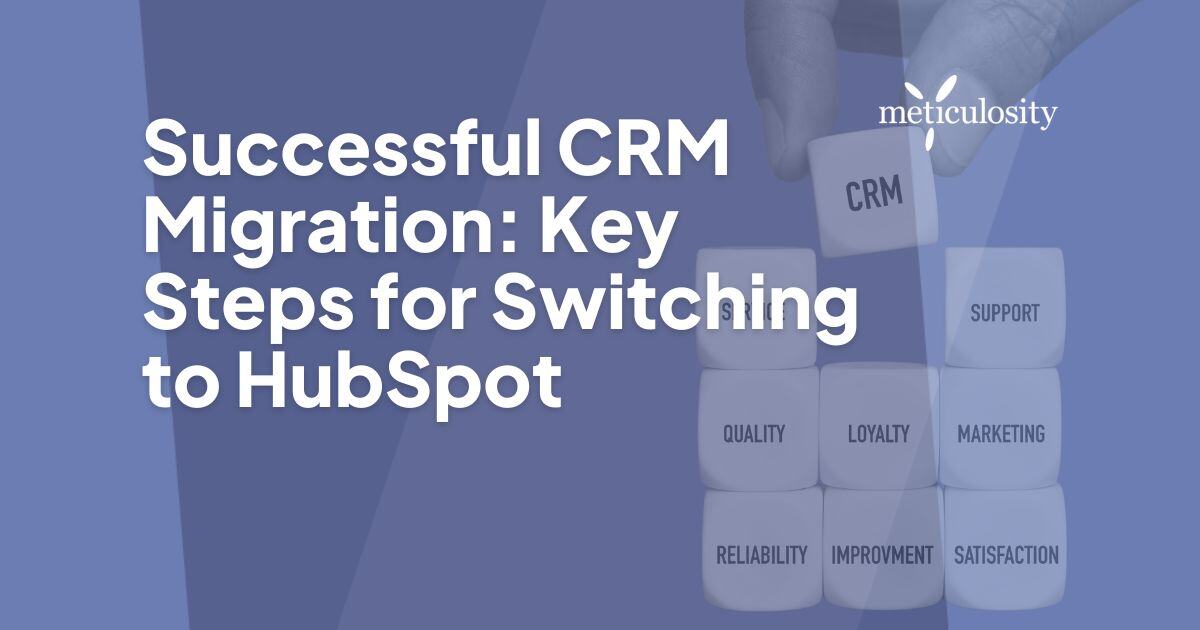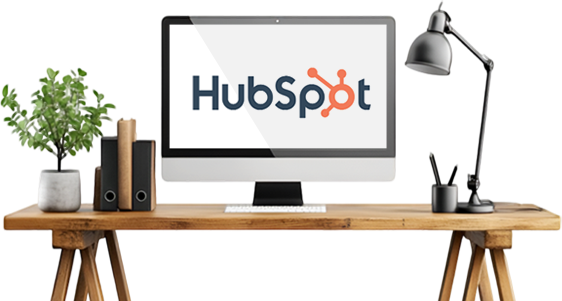Switching CRM systems can be a significant undertaking, but it offers numerous opportunities for business growth and efficiency. When moving from Marketo to HubSpot, understanding the unique advantages and tools provided by HubSpot is crucial.
This platform not only enhances customer relationship management but also offers advanced marketing automation features, an intuitive user interface, and seamless integrations. As you prepare for this transition, it is essential to consider the various components involved, such as data transfer, workflow adjustments, and organizational change. This guide will walk you through each step, ensuring that your transition to HubSpot is smooth and successful.
Explore our HubSpot Onboarding Services to learn how we can help make your migration seamless and efficient!
Getting Ready for Data Transfer
Preparing for a successful data transfer is a foundational step in CRM migration. Start by identifying the essential data you need to transfer to HubSpot. This includes customer records, interaction histories, and any other critical information. It's vital to ensure data accuracy and cleanliness before migration.

This means deduplicating records, correcting inaccuracies, and organizing the data in a manner that aligns with HubSpot’s structure. A thorough data audit will facilitate a smoother transition and prevent potential disruptions.
Strategies for Transitioning Workflows
Transitioning workflows from Marketo to HubSpot can be simplified with a step-by-step approach:
- Map out current workflows: Document each process, highlighting key steps and dependencies, to compare with HubSpot’s functionalities and identify areas for improvement.
- Leverage HubSpot tools: Use features like automated task assignment to streamline operations and advanced reporting for actionable insights.
- Prioritize critical workflows: Focus on recreating essential processes first using HubSpot’s visual workflow builder for a seamless setup.
- Communicate with stakeholders: Keep teams informed about new workflows and their benefits to encourage collaboration and reduce resistance.
- Test and refine: Build test workflows in HubSpot to identify issues, validate processes, and make adjustments before full implementation.
By tackling each step methodically, you can enhance efficiency and unlock the full potential of HubSpot’s robust capabilities.
Effectively Managing Organizational Change
Clear communication with your team is essential during a CRM migration. Explain the benefits of the new system and how it will enhance their work. Providing training and resources is equally important.
Equipping your team with the necessary skills and knowledge will ensure a smooth transition and minimize resistance. Outsourcing HubSpot management can also significantly elevate an agency's efficiency, scalability, and client satisfaction.
Testing and Resolving Issues
Ensuring the integrity of your data and the functionality of your workflows is paramount during the migration process. Begin by conducting thorough tests to confirm that all customer information, interaction histories, and other critical data have been transferred accurately. Utilize HubSpot’s built-in tools to verify data integrity and ensure that your records are complete and correct.
Next, validate that all workflows and automations are performing as expected. This involves running end-to-end tests on key processes to ensure they operate seamlessly within HubSpot’s environment. Pay close attention to any triggers, conditions, and actions to confirm they are functioning correctly.
Address any issues that arise promptly. Data discrepancies or workflow errors should be resolved immediately to prevent any impact on your business operations. Collaborate with your team to troubleshoot problems, leveraging HubSpot’s support resources if needed.
It’s also beneficial to set up a sandbox environment where you can test changes without affecting your live data. This controlled setting allows you to identify and fix issues in a risk-free space.
Monitoring your system closely during the initial stages of the transition is crucial. Implementing real-time monitoring tools can help you quickly detect and address any irregularities. Regularly review your analytics and reporting to ensure that your performance metrics are aligned with your expectations.
By maintaining a proactive approach and promptly addressing any issues, you ensure a smoother transition and uphold the reliability of your operations. Continuous monitoring and refinement are key to sustaining efficiency and leveraging the full potential of HubSpot’s robust platform.
Completing the Migration Process
After completing your tests, it's crucial to review the entire migration process thoroughly. This includes assessing whether all migration goals have been achieved and ensuring no critical elements have been overlooked. Celebrate the transition's success with your team to recognize their dedication and hard work. Acknowledging the collective effort not only boosts morale but also fosters a collaborative spirit for future projects.
Recognizing team contributions is an effective way to maintain high levels of motivation and encourage continuous engagement. Highlight specific achievements and improvements that have been realized through the migration to HubSpot, reinforcing the positive impact on the business.

Consider collaborating with professionals to further enhance your capabilities. Partnering with experts like Meticulosity can provide additional support, improving quality and simplifying complex development projects related to HubSpot. Partnering with experts like Meticulosity can also enhance capacity, improve quality, and simplify development projects when working with HubSpot. This partnership allows you to leverage specialized knowledge and experience, ensuring your team remains focused on strategic initiatives.
Continue to monitor the system closely post-migration to identify any areas that may require adjustment or optimization. Utilize HubSpot's analytics and reporting tools to track performance metrics and ensure alignment with your business objectives. Regularly reviewing these metrics will help you maintain efficiency and capitalize on HubSpot's robust features.
Emphasize the importance of ongoing training and support for your team. Keeping your staff well-informed about new features and updates within HubSpot will ensure they remain proficient in using the system to its fullest potential. This continuous development approach will help sustain the benefits achieved through the migration and contribute to long-term success.
Wrap-Up and Conclusion
A successful CRM migration requires strategic planning, clear communication, and robust training. Prioritize data preparation for a seamless transfer and leverage HubSpot’s tools to streamline workflows and enhance efficiency.
Thorough testing ensures data accuracy and workflow functionality, while ongoing monitoring and refinement maximize HubSpot’s potential. Collaborating with experts simplifies complex tasks and helps align performance metrics with business goals.
Commit to continuous training to keep your team proficient and adaptive to HubSpot’s latest updates. By following these practices, you’ll unlock HubSpot’s full capabilities, driving operational efficiency and stronger customer engagement.
Explore our HubSpot Onboarding Services to make your migration seamless and successful!
Common FAQs About CRM Migration to HubSpot
1: Why should I migrate from Marketo to HubSpot?
HubSpot offers intuitive tools, advanced marketing automation, and seamless integrations that enhance efficiency and improve customer relationship management. Its user-friendly interface makes it accessible for teams across departments.
2: How do I prepare my data for migration?
Start by auditing your data to ensure accuracy. Deduplicate records, correct inaccuracies, and organize information to align with HubSpot’s structure. This minimizes disruptions and ensures a clean data transfer.
3: What workflows should I prioritize when transitioning?
Focus on critical workflows that directly impact your business operations. Recreate these first using HubSpot’s visual workflow builder, which simplifies even complex processes.
4: How can I ensure my team adapts to the new system?
Communication is key. Clearly explain the benefits of HubSpot, provide hands-on training, and offer ongoing support. This helps reduce resistance and empowers your team to use the platform effectively.
5: What testing steps are crucial during the migration?
Validate data accuracy, test workflows, and run end-to-end checks on key processes. HubSpot’s built-in tools and a sandbox environment can help you identify and fix issues before going live.
6: Can I migrate without disrupting my daily operations?
Yes! By following a phased migration approach, prioritizing critical workflows, and testing thoroughly, you can ensure minimal disruption to your business operations.
7: How can HubSpot’s analytics improve my processes post-migration?
HubSpot’s advanced analytics provide insights into performance metrics, helping you identify areas for optimization and align processes with your business goals.
8: Should I partner with experts for my migration?
Collaborating with experts like Meticulosity simplifies the migration process, enhances quality, and allows your team to focus on strategic initiatives while leveraging specialized knowledge.
9: How can I keep my team updated on HubSpot’s features?
Regular training sessions and updates on new tools or features ensure your team stays proficient, driving continuous improvement and maximizing the platform’s value.
10: What are the long-term benefits of migrating to HubSpot?
A successful migration improves customer engagement, enhances operational efficiency, and provides a scalable platform to support your business growth.







